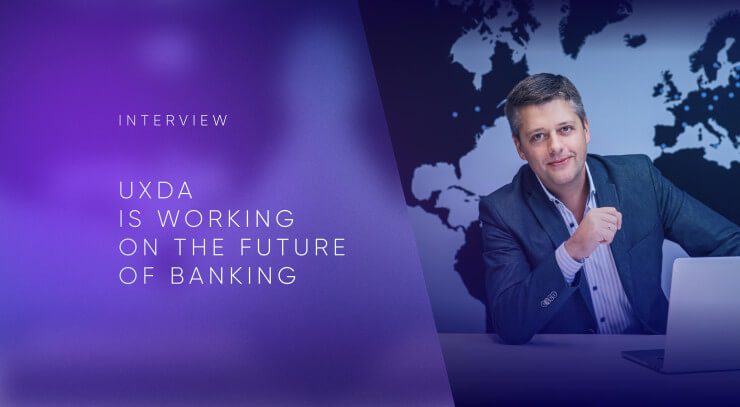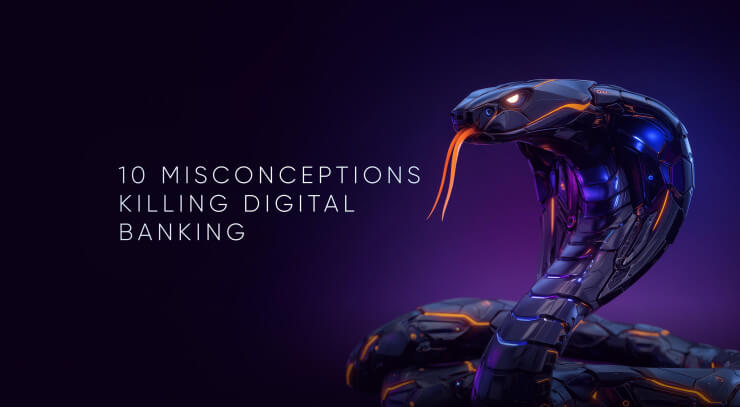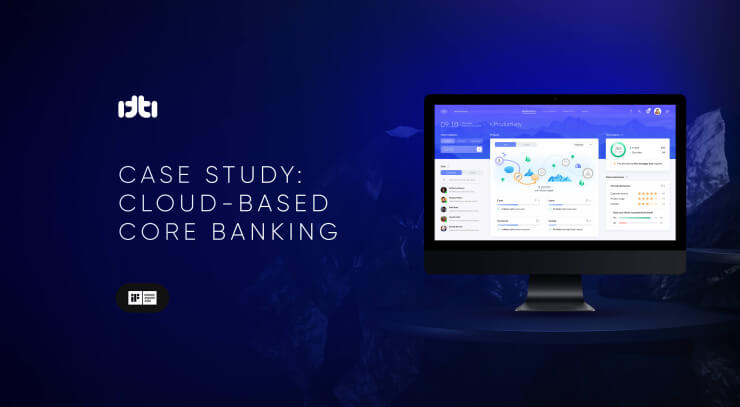What would an iPhone look like if one of the banks designed it? The modern banking executive faces a pervasive challenge: how to implement banking innovation effectively in a rapidly evolving digital landscape. They are increasingly drawn to the allure of cutting-edge technologies─from AI and blockchain integration to cloud-based infrastructure and open banking APIs. However, when creating digital financial products and services, this tech-driven focus might overlook the essential component of the user experience (UX), leading to potential pitfalls. This article explores how a user-driven approach to innovation can empower financial brands’ survival and success in the digital age.
Test Your Bank: Are Your Banking Innovation Mainly Tech-Driven?
The Pressure to Keep Up and Adopting a Tech-First Mentality
Banks face immense pressure to keep up with technological advancements to stay competitive. The rapid evolution of Fintech and digital payment systems forces banks to adopt the latest technologies to avoid being left behind. This often leads to a tech-first approach, in which the primary goal is to implement the newest technology rather than optimize the user experience.
Investors and stakeholders often prioritize technological advancement as a sign of innovation and future growth potential. Banks, seeking to demonstrate progress and competitiveness, invest heavily in new technologies. This establishes a tech-first mentality that leads to complex, user-unfriendly systems that can frustrate customers rather than attract them.
Also, the importance of the user experience is overshadowed by compliance requirements. Financial institutions operate in a highly regulated environment. Compliance with regulatory requirements is complex and resource-intensive. Technology solutions that automate compliance processes are highly valued as they help banks manage regulatory burdens efficiently, but they can often complicate user journeys.
Challenges with Solution Integrators and API Providers
Banks often turn to solution integrators and API providers that promise time and cost savings, as well as shortcuts to regulatory compliance through white-label solutions for features like transaction categorization and payment processing.
The issue is that competent salesmen sell banks these white-label solutions with a promise that the UX/UI can be fully customized. In reality, customization frequently amounts to little more than changing colors from blue to green, offering minimal improvement in the user experience. Consequently, that leaves banks with "new" but highly standardized solutions. Worse still, they often end up locked into expensive, long-term contracts with these vendors with no opportunity to actually enhance their customers' UX.
The Need for Security Without Compromising UX
Prioritizing digital innovations that enhance security is crucial. While securing transactions and protecting data is critical, it should not lead to complex, user-unfriendly systems. For example, reducing a lengthy 5-minute authentication process to just 5 seconds for a secure login demonstrates that advanced tech stacks can coexist with excellent UX.
Outdated legacy systems that are costly and difficult to replace also pose a significant challenge. Integrating new technologies with these systems often focuses on updating technology infrastructure without redesigning the user experience from scratch.
Internal Silos and Fragmented Approaches
Internal silos, in which different departments (e.g., IT, compliance, marketing) work in isolation, contribute to tech-driven rather than user-driven innovations. A fragmented approach lacks the holistic view required for UX-centered design.
After years of adding shiny features without revisiting product architecture and user needs, banks often find even product owners and managers no longer understand their offerings. Constant "innovation" has buried key value drivers under a pile of features, leading users to turn away from these complex solutions. An external perspective from UX experts is required to prioritize and simplify, allowing users to rediscover the value of the financial brand.
Financial Aspects and ROI
Return on investment (ROI) for technological innovations is often easier to measure and justify than for UX and product design improvements. Technology investments can be directly linked to efficiency gains, cost savings and enhanced capabilities. In contrast, the benefits of improved UX, such as customer satisfaction and loyalty, can be harder to quantify and justify to stakeholders. Consequently, product teams might prioritize adding new functionalities to their digital platforms.
Hidden Pitfalls of Tech-Driven Banking Innovation
Tech-driven innovation in banking can provide short-term competitive advantages and quick wins in the market. User-driven financial innovations often require extensive user research, design and testing, taking longer to develop and implement, yet precisely this approach creates long-term advantages for businesses.
Fundamentally, when innovation in banking is introduced through a tech-driven approach, its potential and value are often reduced. So, based on all of the above, we can extract some key pitfalls of tech-driven banking innovations that very often remain in the shadows:
- Copycat Features. Catching up on trends and competitive pressures results in similar digital offerings across the industry. Decisions are made based on benchmarking rather than user feedback, resulting in a disconnect between the service and its users.
- Over-Featuring. There is often a misconception that more features equate to better products. Banks might prioritize adding new functionalities to their digital platforms, believing this will attract more customers. However, without a focus on how users experience these features, this can lead to a cluttered and confusing user interface and overwhelmed users who cannot find what they are looking for.
- Lack of Authenticity. Generic, one-size-fits-all digital solutions provided by vendors could fail to cater to the specific needs of exact financial brand customers and their unique identities. To evoke an emotional bond with the user, every tiny detail should express the authenticity of the brand.
- Complexity. Tech obsession without user-centricity can result in implementing complex systems that are difficult for users and employees to navigate, impacting the overall user experience. This can result in frustration and decreased satisfaction among users who find the new platforms difficult to use.
- Lack of Personalization. May not effectively address individual user needs, leading to generic and less engaging user interactions. AI can be used to tailor financial advice and product recommendations based on individual user data.
- Innovation for Innovation’s Sake. The focus is on integrating the latest technology, such as AI, blockchain or advanced analytics, simply because they are new and perceived as cutting edge by customers. This can expose banks to increased security risks.
- Fragmentation. Tech-driven innovations in banking can lead to disjointed user experiences if they are not seamlessly integrated into the existing banking ecosystem to ensure consistency. This can frustrate customers and erode brand loyalty.
- User Feedback Ignorance. Banks that focus on technology often miss out on valuable user feedback. They may invest heavily in new technologies without considering how these financial innovations affect the user experience, leading to stagnation in service quality.
- Weak Emotional Connection. Overemphasis on technology can result in sterile, impersonal interactions. Customers who do not feel emotionally connected to their bank are more likely to switch to a competitor, reducing long-term customer retention.
- Inconsistent Digital Identity. Rapid integration of new technologies without a cohesive strategy can lead to inconsistent user experiences across different platforms and services. Consistent visual language and usability patterns are crucial for building a strong, recognizable digital identity that customers can trust.
Benefits of User-Driven Innovation for Banks: Apple’s Mojo
If we compare Nokia and Apple in 2007, we will see that the same technical innovations were available to Nokia. But Apple was able to use them to fundamentally reimagine the user experience and create the next generation of devices. And Nokia used these same disruptive innovations to marginally update its already outdated devices and ended up losing the market.
Apple's success provides a compelling case for user-driven innovation. Apple's philosophy prioritizes user needs and behaviors, leading to products that are not only technologically advanced but also intuitive and enjoyable to use. A user-driven approach allows Apple to evaluate and implement each technology from the user experience enhancement perspective, which can be particularly beneficial for the banking industry.
For instance, Apple Pay simplifies transactions to a single touch, ensuring security and ease of use. Such user-centric innovations in finance enhance trust and convenience─crucial elements in financial services.
At the WWDC 2024 event, we were introduced to on-device AI (Apple Intelligence), which aims to become a personalized AI advisor, helping to perform everyday tasks to provide a contextual experience. Unlike cloud-based AI chat, Apple's on-device AI processes data directly on the user's device, ensuring seamless AI technology integration to enhance, rather than complicate, existing user journeys.
Apple’s products, such as the iPhone and Apple Watch, are designed with the user in mind. This user-centric approach has fostered a highly loyal customer base, with over 90% customer retention for the iPhone. To achieve similar loyalty, banks can address customer pain points and deliver seamless experiences tailored to their business strategy, customer needs and brand identity.
An intuitive interface and the seamless integration of smart services across the Apple digital ecosystem keep users engaged. The ease of use and consistent experience across devices encourage frequent interaction. The creation and development of a consistent digital ecosystem is the best basis for user-driven innovations in banking.
In general, the ease of use and integration of Apple’s ecosystem encourages users to adopt new services and products─from Apple Pay to various apps available in the App Store. By creating user-centered digital platforms that are easy to use and offer real value to customers, banks can drive higher adoption rates of online and mobile banking services. Features such as easy account setup, straightforward navigation and valuable financial tools can encourage more customers to try other innovative features.
Apple’s UX is a key differentiator in a crowded market. The company’s commitment to design excellence, perfect execution and user satisfaction has helped it stand out from other tech giants. Prioritizing UX can differentiate any financial company from hundreds of competitors who may focus solely on technological advancements. Financial brands known for their exceptional user experience attract more customers, even in a highly competitive environment.
Apple’s products are constantly innovating, but in an intuitive, friction-less way, reducing the need for extensive customer support. The company also invests in self-help tools, further minimizing support costs. Automated solutions and well-designed self-service options in banking can handle many common issues, freeing up resources for more complex support needs.
To mirror the Apple-inspired success, banks can shift from a tech-driven to a user-driven banking innovation approach. It will secure obvious benefits for a bank or any other financial company:
- Enhanced customer loyalty and retention
- Increased customer engagement and satisfaction
- Competitive differentiation
- Improved operational efficiency
- Higher ROI and new revenue streams
- Stronger brand authenticity and trust
- Better adaptation to customer needs and tech trends
- Enhanced emotional connection
- Increased adoption of digital services
- Sustainable growth and banking innovation
Empower your Digital Service: Make Banking Innovation User-Driven
User-driven innovations in banking focus on understanding and enhancing the user experience through the thoughtful application of technology. This approach prioritizes the needs, preferences and behaviors of users, ensuring that innovations create real value and improve the overall customer journey to make financial services simpler, more accessible and more enjoyable and not just to keep up with competitors.
Unlike the tech-driven approach, user-driven banking innovation is proactive and involve extensive user research, feedback loops and iterative design processes to align new products and services with what users actually want and need.
Understanding user psychology is crucial for effective innovation in banking. Customer-centered design acknowledges the cognitive and emotional aspects of user interactions. Banks can take cues from behavioral economics to design systems that reduce friction and enhance user satisfaction. For example, simplifying account management and providing clear, actionable insights into spending can significantly improve user engagement and loyalty.
Apple's UX strategy involves extensive user testing and feedback loops to refine products continuously. Banks can adopt similar strategies to ensure their innovations align with user needs and expectations, leading to more effective and user-friendly financial products. From the UXDA experience in turning tech-driven innovations into user-driven ones for over 150 financial products in 37 countries, we can define 10 key strategies:
- User-Centricity. Focus on implementing financial innovations into intuitive, easy-to-use interfaces and processes that enhance the user experience.
- Simplicity. Strive to simplify processes and reduce the cognitive load for users, making interactions more enjoyable.
- Personalization. Utilize data to provide tailored experiences and recommendations that meet individual user needs.
- Feedback Loop. Continuously refine innovations in banking based on user feedback, ensuring ongoing improvements and relevance.
- Transparency and Trust. Build trust with users, ensuring they understand how their digital data is used and the benefits of innovative services provided.
- Emotional Connection. Aim to create an emotional bond and long-term engagement with users, making them feel valued and understood.
- Seamless Integration. Seamlessly integrate user-driven financial innovations across various platforms and devices, providing a consistent and uninterrupted user journey.
- Problem-Solving Focus. Design user-driven innovations to solve specific user problems, enhancing the overall utility and value of the services.
- Data-Driven Decisions. Use customer data and analytics to drive the development and refinement of products, ensuring banking innovation decisions are informed by actual user behavior and needs.
- Inclusive Design. Design all innovations to be accessible and inclusive, catering to a diverse range of users, including those with disabilities.
Conclusion: Innovation in Banking will not Save Banks from the Digital Disruption
Banks are undergoing a total digital transformation. By digitizing their services, they are essentially becoming technology companies. Therefore, future survival will directly depend on the ability to integrate cutting-edge innovations. But banking innovation alone will not save traditional banks, and may even harm them.
If a financial company is ready to move away from a purely tech-driven approach and embrace user-driven innovations in banking, it should start evaluating every feature from a user need and behavior perspective. This shift will enhance digital customer satisfaction while driving long-term success in the competitive banking landscape. Adopting a UX-centered strategy and culture could help banks and other financial companies navigate the complexities of digital transformation and secure a sustainable future.
Involve users early and often in the design process. Use tools like user personas, journey mapping and usability testing to create products that align with user needs. Prioritize essential innovations that provide clear value to users. Avoid cluttered interfaces and excessive features that complicate the user experience.
Establish mechanisms for ongoing user feedback. Use this data to make iterative improvements to products and services. Balance security and convenience. Educate users on safe practices and implement intuitive security features that do not impede the user experience.
A switch to user-driven banking innovation ensures that the technology meets the actual needs and preferences of users, leading to a more intuitive and satisfying experience. It helps to establish trust and an emotional connection with the financial brand, which is crucial for retaining customers in a competitive market. By continuously incorporating user feedback, digital services can evolve through user-driven innovations more effectively, driving higher adoption rates and ensuring long-term success.
Get UXDA Research-Based White Paper "How to Win the Hearts of Digital Customers":
 If you want to create next-gen financial products to receive an exceptional competitive advantage in the digital age, contact us! With the power of financial UX design, we can help you turn your business into a beloved financial brand with a strong emotional connection with your clients, resulting in success, demand, and long-term customer loyalty.
If you want to create next-gen financial products to receive an exceptional competitive advantage in the digital age, contact us! With the power of financial UX design, we can help you turn your business into a beloved financial brand with a strong emotional connection with your clients, resulting in success, demand, and long-term customer loyalty.
- E-mail us at info@theuxda.com
- Chat with us in Whatsapp
- Send a direct message to UXDA's CEO Alex Kreger on Linkedin



















